#cable chain stitch
Explore tagged Tumblr posts
Video
youtube
How to do Cable Chain Stitch
3 notes
·
View notes
Text





My Coworker’s Mom’s blanket is complete!
My squares are, from top to bottom: 4th on row 1, 2nd, 3rd, & 4th on row 2, 1st & 2nd on row 4, and 1st & 2nd on row 5. All the rest are CMom’s. When choosing the squares I’d do, I picked a mix of graphic ones (the trees), cables, openwork/lace and textured patterns, to go with the ones CMom made.
Once all my squares were done, I made sure all 20 had crocheted borders with the same number of stitches per side and then crocheted them all together. Finally, I put on one of my favorite blanket borders: one wrong-side row of half-double crochet (so the ‘extra’ bar of the stitches ends up on the right-side), and one right-side row of {backward single crochet+chain two+skip one} repeated. I love borders with backward crochet stitches; I think they make things look so ‘finished’ on the edges.
So, hopefully there will be a day soon when Coworker and I are at the office at the same time (rare) so I can show her these photos and set up when I can give this to her. <3 I really enjoyed completing her Mom’s final creation and I hope she’ll think I did it justice!
Thanks to everybody on my original post about this who encouraged me and sent kind messages. I didn’t expect this to attract attention like it has and I’ve had fun reading other people’s similar stories. As I said in the reblog chains on that post, crafting really brings people together! So hey, all you knitters, crocheters, and other assorted fiber-craft creators—hope you’re having a great time with your projects!
2K notes
·
View notes
Text




The chain cable sweater is done! It is indeed intended to be a crop top, by request of the recipient. The yarn is 100% alpaca so it's super soft and cuddly.
The chain cable came from this video tutorial. There's no written pattern, so here's the instructions I transcribed (just for the cable, not for the sweater itself). It's a bit fiddly and you need to be careful about row counting, but it came out looking so good!
Chain cable
9 stitches across
Knit right side/purl wrong side for nine rows
Chain (RS):
K 6, turn, (slip 1, p 2, turn, slip 1, k 2, turn) x 2, slip 1, p 2, turn
Transfer 3 stitches to cable needle and hold in front
Put next three stitches on cable needle also and hold in front
Transfer 3 stitches from right needle to left needle
Knit last three stitches from cable needle
Knit first three stitches (with short rows) from cable needle
Knit 3
48 notes
·
View notes
Text
I wrote warriors angst, and I also gave him siblings and some ~trauma~
I hope you like it!
14 notes
·
View notes
Text
National Crochet Month
I am so behind on the fact that it is national crochet month! So here's a speed run of the first few days. And if you'd like me to expand some more on anything, my ask box is a open!
1. Meet the Maker -*waves* Gavii. Mostly crochet doilies but multistitchin with a current focus on blankets. 3 dogs. FFXIV. Thunderbirds.
2. WIP -I have four: a pair of socks, my long term temp blanket for the year, my FFXIV inspired blanket, and a quick market bag that just needs some straps added
3. Favorite Stitch - I'm rather partial to the HDC for its versatility with three loops
4. Something I'd like to try - Next on my to learn list is knit cables. I'd love to make a cabled hat. For crochet, I'm interested in trying mosaic or tapestry.
5. Being Silly - ? No, thank you?
6. Full of color - Hedgehog Fibres -
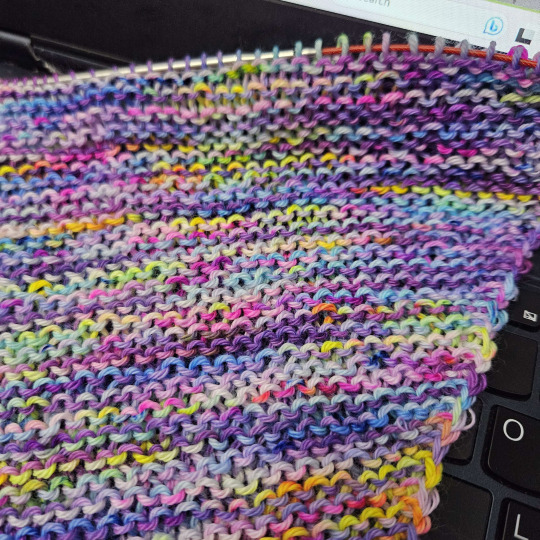
7. Stash - I don't want to talk about it. Here's some Happy Place instead
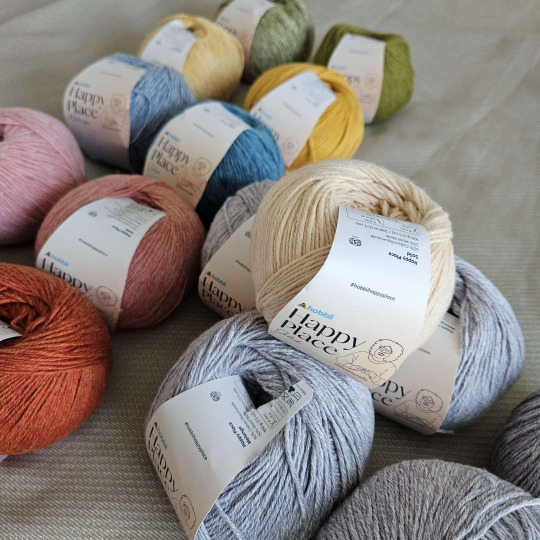
8. Crochet controversy - magic circle or chain start - like most things, it depends. I'll do magic circle to start doilies, especially if it's asking for sc. But for larger yarn weights and things like grannies, I prefer chain start because it feels more secure.
9. How I learned - I started on granny squares and my mom taught me - the rest I learned from reading patterns, trial and error, and watching youtube
10. Throwback Thursday This was a wedding gift I made a few years back
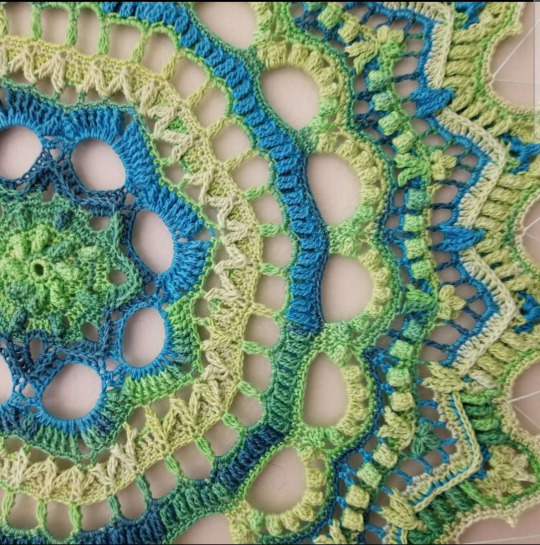
11. Texture - yes. I am a big fan of front post stitches, and like in the above, I adore when mandalas or doilies are designed with complexity.
15 notes
·
View notes
Photo
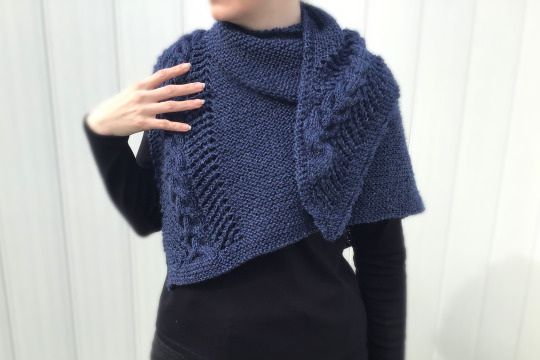

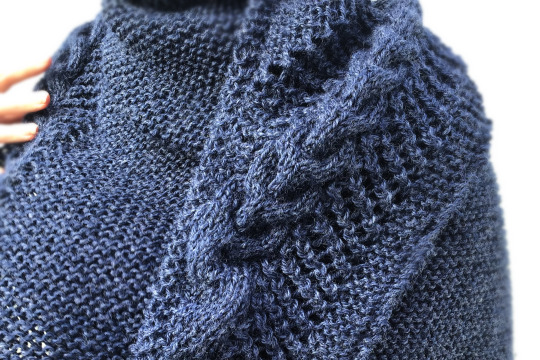
Chains and Lattice cable knit shawl -- here on Etsy!
Cable knit shawl or wrap, featuring a pattern of lacey lattice and a band of interlocking chain-like cables. The garter stitch body of the shawl is light and fluffy soft!
49 notes
·
View notes
Text
First time attempting to crochet a winged cable stitch. I start with a base chain of 36. Row of single crochets. Then the row with the cables. I get to the end and I have three 'leftover' stitches instead of two. I count. Yeah thats somehow 37. Throw in a decrease and finish the row. Next row of single crochets, counting as I go, now there are 35.
Sometimes in general Im off by one, and I thought it was that I was doing the starting slip stitch wrong, but I followed this person exactly. This tutorial btw by B.Hooked https://www.youtube.com/watch?v=N2Vn5gyiQqg
I just recounted my starting chain and theres 36.
Any idea what the heck is going on? Do I throw in an increase and play hide and seek with this moving stitch? Actually I dont have enough of this yarn for another row but I might have the same in a different colour.
Will add a photo in a sec.
Tadaaah
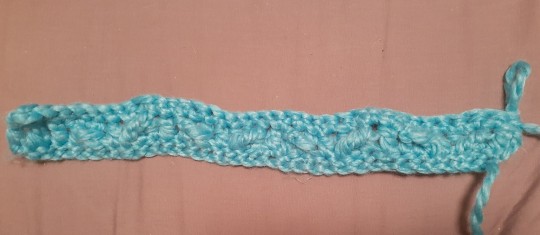
3 notes
·
View notes
Text
Crafting predictions for 2024
Out
Using stitch markers
The color blue
Knitting from written instructions
Crocheting from charts
Decorating cakes with drips
Making socks
Guessing gauge
Chenille blanket yarn
Yarn shaming
In
Reversible cables
Basketry
Knitting from charts
Crocheting from written instructions
Heathered yarn
Making tabi socks
Aggressive blocking
Handmade shoelaces (just chain stitch)
Fun fur
6 notes
·
View notes
Text
Neurodivergent Knitting: Casting On
Let’s face it, casting on is one of the hardest parts of knitting to learn, and sometimes one of the hardest to implement. Here are four of the most common methods and their pros/cons for the disabled and/or neurodivergent knitter.
Simple Cast On (single twist)
The easiest to execute, but one of the hardest to work stitches out of, especially if you have hand disabilities. It is a very stable casting technique, good for items you don’t want stretchy edges on or for items you want to puff in the middle. It uses no extra yarn, so you don’t need more than a couple of inches of tail (that way you actually have something you can weave to hide it later). Where it gets tough is that it has no gauge regulation of its own--the tightness of each stitch is 100% controlled by the knitter, so the tiniest moment of carelessness can pull a stitch too tight to get a second needle into it to work it. All you have to do to execute the simple cast on is to place a slipknot on your right needle, take your live yarn (the end connected to the skein/ball), give it a single clockwise twist so that it makes a closed loop, slide the loop onto the needle, and pull fairly tight--the tightness here has a big influence on the gauge of the bottom border, and if you make it too loose you may find it difficult to get any kind of uniformity going. When you look at your needle, it should look very similar to a sewing blanket stitch--vertical bars spaced out with yarn traveling horizontally between them, and the horizontal part should look kind of like it’s weaving in and out, in this case over the stitch it came from and under the stitch it’s going into.
Super Stretchy Cast On (double twist)
This one shares many of the same characteristics as the single twist cast on, both the positive and the negative, with one HUGE difference: this cast on will give you stretch instead of stability. The amount of stretch is variable, and tends to adjust itself based on what you work out of it on the first few rows of the work. It’s ideal for a rib or cable pattern with no bottom border, including top-down socks and gloves, cowls, hats, or limb-warmers. The stretchy cast on is most easily executed by placing a slipknot on the working needle, taking the live yarn, making a loop/twist like before, then twisting it one more time before sliding it onto the needle. The biggest challenge when using this cast on is that if you do not slide the stitches close together and pull up all their slack, they become irregular in size later. As a result, your first row working into them will be tight, just like with the simple cast on.
Crochet Cast On (picking up stitches)
This is probably the second-easiest to execute. Nothing fancy here, just make a slipknot, chain however many stitches you want to cast on. Then you get your knitting needle and pick up the back bar of each chain stitch (I say back bar because it makes what crocheters call a ‘neat edge’ at the bottom, but you can pick up the front top if that’s easiest for you). It is a very stable edge, but has a bit more give to it than the simple cast on, and makes a somewhat ornamental, very visible bottom edge. This cast on is the gentlest, sensory-wise, as you have no extra yarn touching you and there is little risk of the stitch getting too tight to work.
Long Tail Cast On (two-strand cast on)
Personally, I hate long tail. If you don’t judge the length of your tail correctly, you’ll either run out before you’ve cast the right length or you’ve got all that wasted yarn. I’m so, so bad at estimating that kind of length. That being said, it is extremely easy to work into, and is the foundation of most provisional/invisible cast on techniques (which allow you to make live-stitch borders that allow you to work both up and down from the same edge with no seam, very handy for fancy borders). To execute the long-tail cast on, first acknowledge that you’re probably going to estimate your tail length wrong and be ready to sacrifice a few inches of yarn (I’ve been told that the simplest way to estimate is to get two to three times as much length as the width of your work, depending on the size of needle, but let me tell ya, this definitely doesn’t always work for me...). It’s like cooking pasta or making buttercream frosting: size up the project, estimate the amount you think you’ll need, you are wrong. Now that you’ve come to terms with the loss and reminded yourself that it’s not your fault and you’re going to trust the process...twist the yarn around the needle so that you have the dead yarn (the tail end) crossing over the top of the live yarn (the skein end). With my mobility issues, I’ve found it easiest to hold my live yarn like I always do (behind the index, in front of middle and ring fingers, behind the pinky; sometimes, if the yarn feels like it’s getting away from me, I’ll slow it down by looping around my pinky once) and hold my dead yarn looped around my thumb and using my ring finger or pinky to catch up fresh loops. It’s difficult to execute this cast on if you hold the two ends in different hands, but it is possible if you don’t have enough control in your yarn hand--in that case, hold the dead yarn to the left (the ‘bottom’ of the cast edge) and the live yarn to the right (the ‘top’ of the cast edge); this is also the easy way for knitters who hold their yarn English style. Okay! All that complicated stuff is out of the way. Now is where it gets extremely simple: You’re going to make a single twist on the dead yarn (as if you were casting it onto the needle; as I mentioned, I like to keep this loop ready on my thumb, as if my thumb were my left needle), insert your needle knitwise and use your live yarn to knit a stitch onto your needle while dropping the twisted loop from your thumb and tugging the slack tight. That’s it. That’s all it is. Just using loops on a tail to knit through. You can even use scrap yarn from the same skein or dye lot and have your tail be a totally separate piece. You can use a contrasting yarn for the tail and then come through and add a border by using that contrasting yarn to find where to pick up stitches, after which you can just remove the contrasting yarn (this is called a provisional or temporary cast on, and it’s the easiest way to leave live stitches for a decorative edge). Sensory-wise, since you have two distinct strands of yarn doing two different tasks, this method is kind of icky; for me, I spend the whole time mentally chanting ‘nope’ while I remember that I have Big Plans™ for a fancy edge.
#actually disabled#yarncraft#actually neurodivergent#yarncraft for neurodivergents#neurodivergence#stimming
3 notes
·
View notes
Text
Single needle machine for closing of all kinds of filled bag
Portable two thread stitch sewing bag closing machine Portable two thread chain stitch bag closing machine with direct drive by fan-cooled electric motor. Combined upper and lower feed for greater power grips both sides of the bag, even on difficult materials. Motor housing and handle made of fiber-glass reinforced break-resistant polyamide. Sealed, dust proof and permanently lubricated motor ball bearings. Power cable 5 m long.
Thank you for allowing Accurate Weighing Scales (U) Ltd the privilege to serve you in advance. For inquiries on deliveries contact us Office +256 (0) 705 577 823, +256 (0) 775 259 917 Address: Wandegeya KCCA Market South Wing, 2nd Floor Room SSF 036 Email: [email protected]
0 notes
Text
needle thread double lock chain stitch bag closing machine
Portable two thread stitch sewing bag closing machine Portable two thread chain stitch bag closing machine with direct drive by fan-cooled electric motor. Combined upper and lower feed for greater power grips both sides of the bag, even on difficult materials. Motor housing and handle made of fiber-glass reinforced break-resistant polyamide. Sealed, dust proof and permanently lubricated motor ball bearings. Power cable 5 m long.
Thank you for allowing Accurate Weighing Scales (U) Ltd the privilege to serve you in advance. For inquiries on deliveries contact us Office +256 (0) 705 577 823, +256 (0) 775 259 917 Address: Wandegeya KCCA Market South Wing, 2nd Floor Room SSF 036 Email: [email protected]

#electrical services#architecture#buildings#electric#photography#maintenance services#electrical companies#electrical wiring#electrical service#electrical installation
0 notes
Text
Automatic single needle industrial closing machine for bags
Portable two thread stitch sewing bag closing machine Portable two thread chain stitch bag closing machine with direct drive by fan-cooled electric motor. Combined upper and lower feed for greater power grips both sides of the bag, even on difficult materials. Motor housing and handle made of fiber-glass reinforced break-resistant polyamide. Sealed, dust proof and permanently lubricated motor ball bearings. Power cable 5 m long.
Thank you for allowing Accurate Weighing Scales (U) Ltd the privilege to serve you in advance. For inquiries on deliveries contact us Office +256 (0) 705 577 823, +256 (0) 775 259 917 Address: Wandegeya KCCA Market South Wing, 2nd Floor Room SSF 036 Email: [email protected]

#exercise#platform scales#moisture meters#kitchen scales#barcode printers#food#health & fitness#bathroom scales
0 notes
Text
two thread double locked chain stitch bag closer machine
Portable two thread stitch sewing bag closing machine Portable two thread chain stitch bag closing machine with direct drive by fan-cooled electric motor. Combined upper and lower feed for greater power grips both sides of the bag, even on difficult materials. Motor housing and handle made of fiber-glass reinforced break-resistant polyamide. Sealed, dust proof and permanently lubricated motor ball bearings. Power cable 5 m long.
Thank you for allowing Accurate Weighing Scales (U) Ltd the privilege to serve you in advance. For inquiries on deliveries contact us Office +256 (0) 705 577 823, +256 (0) 775 259 917 Address: Wandegeya KCCA Market South Wing, 2nd Floor Room SSF 036 Email: [email protected]

0 notes
Text
MASTER LIST OF MY FICS
BHNA - MY HERO ACADEMIA (RARE POSTS)
Broken Stars (series) - Izuku hails from the year 2020, where quirks first appear. Genderbent!Deku, OFA!Uraraka, Dadzawa. Being co-written by @yinyangprophecy. IN PROGRESS
Only Children - Villain!Deku one-shot, told from Bakugo's perspective. Ambiguous ending. AU discontinued. COMPLETE
FULLMETAL ALCHEMIST
Stories from Amestris (1890-1915) (series) - AU featuring my OC, Dorothy Mustang. Written in an epistolary style and is heavily focused on worldbuilding. All fics with Dorothy will be able to be found here. IN PROGRESS/ON HIATUS
A Truth Universally Acknowledged - Victorian AU. Royai. Short one-shot, may be expanded upon eventually. COMPLETE
On the Topic of Sentience - A silly little one-shot. Vaguely modern AU. COMPLETE
The Hidden Beauty of Unfinished Seams - Oneshot. Seamstress!Riza AU. Royai. COMPLETE
THE MATILDA SAGA
Sugar Rations and Christmas Carols - Christmas fic. Short one-shot, post-canon (compliant up until end of book 4). COMPLETE
POKEMON
a heart's a heavy burden - Lance/OC, featuring Cecilia; the dressmaker and fashion designer from Viridian City who has...a messy family. Follows the anime (generally), but includes elements from the games. IN PROGRESS
Step Boldly - nevermoor/pokemon crossover, featuring lance and cecilia. takes place mostly ~17 years before the first nevermoor book, and includes some of the other champions from pokemon as side characters. oneshot. COMPLETE
Legend of Zelda/Linked Universe
Poppies in Blatchery Plain - Wild-centric, angst. Oneshot, Linked Universe. In which Wild has some trauma, and a field of poppies looks like a sea of blood. COMPLETE
Cable Chain Stitch - Warriors-centric, angst. Oneshot, Linked Universe. Canon-divergent. In which Warriors never wanted to be a hero, but he has two families to help him through it. Implied past rape. COMPLETE
the rivers when they run - Hyrule-centric, hurt/comfort (mostly hurt). Oneshot, Linked Universe. Canon-divergent-ish. In which Hyrule's Hyrule is based off Australia, and sees the first heavy rain since before Hyrule was born. Hyrule had never known it could rain so much. COMPLETE
#will be edited as I write more!#fullmetal alchemist#fanfic#fma#fma fanfiction#aus galore#bhna fanfiction#the matilda saga#pokemon fanfiction#aus and ocs galore#nevermoor#legend of zelda#loz#loz fanfic#linked universe#lu fic#lu
3 notes
·
View notes
Text
Automatic single needle industrial closing machine for bags
Portable two thread stitch sewing bag closing machine Portable two thread chain stitch bag closing machine with direct drive by fan-cooled electric motor. Combined upper and lower feed for greater power grips both sides of the bag, even on difficult materials. Motor housing and handle made of fiber-glass reinforced break-resistant polyamide. Sealed, dust proof and permanently lubricated motor ball bearings. Power cable 5 m long.
Thank you for allowing Accurate Weighing Scales (U) Ltd the privilege to serve you in advance. For inquiries on deliveries contact us Office +256 (0) 705 577 823, +256 (0) 775 259 917 Address: Wandegeya KCCA Market South Wing, 2nd Floor Room SSF 036 Email: [email protected]

0 notes
Text
Portable two thread stitch sewing bag closing machine
Portable two thread stitch sewing bag closing machine Portable two thread chain stitch bag closing machine with direct drive by fan-cooled electric motor.
Combined upper and lower feed for greater power grips both sides of the bag, even on difficult materials.
Motor housing and handle made of fiber-glass reinforced break-resistant polyamide. Sealed, dust proof and permanently lubricated motor ball bearings. Power cable 5 m long.
Thank you for allowing Accurate Weighing Scales (U) Ltd the privilege to serve you in advance. For inquiries on deliveries contact us
Office +256 (0) 705 577 823, +256 (0) 775 259 917
Address: Wandegeya KCCA Market South Wing, 2nd Floor Room SSF 036
Email: [email protected]

#Crane (hanging) scales#Whole sale scales#Baby scales#Mini palm scales#Industrial platforms#assorted weighing brands including Avery#Salter#Health ( height and weight ) scales#Precision scales Analytical/Laboratory scales#Moisture meters#Temperature gauges#Pallet trolleys#kitchen scales#Animal scales#Bag closers-stitching machine#Plastic bag sealers#Plastic foot sealers#Batch sealers#Table top scales#Counter scales#Barcode readers/printer#Waterproof scales#Axle weigh bridge#Mini and full Weigh bridges among others.
0 notes